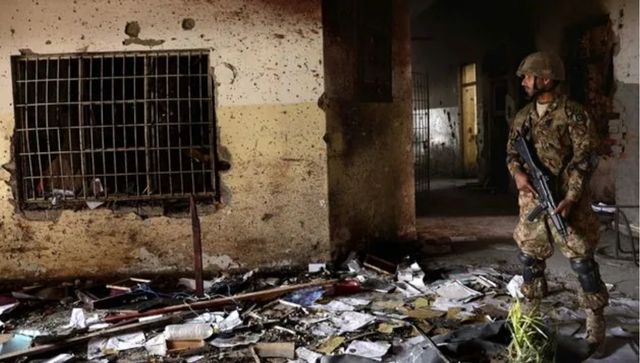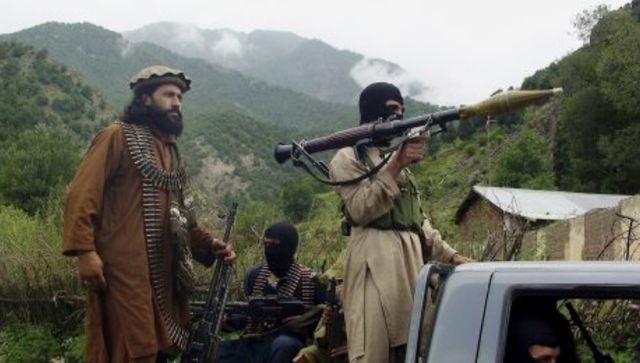
[ad_1]
At least 34 individuals died and 150 have been injured, largely cops, after a suicide bomber blew himself up on Monday (30 January) throughout prayers at a mosque in Pakistan’s northwestern Peshawar metropolis.
Sarbakaf Mohmand, a commander for the Pakistani Taliban, claimed the duty for the assault on Twitter, as per Associated Press (AP).
Over 300 worshippers have been praying inside the mosque in the Police Lines space when the suicide bomber detonated his explosives vest.
The bombing in Peshawar, the capital of Khyber Pakhtunkhwa province which has a robust presence of Tehreek-e-Taliban Pakistan (TTP), was one in all the deadliest assaults on safety forces in Pakistan lately.
Earlier in January, three cops have been killed by a group of heavily-armed TTP militants in Peshawar once they attacked a police station.
The militant assaults on safety forces have ramped up since the TTP ended the ceasefire with the authorities in November final 12 months.
Let’s check out the TTP’s earlier warnings, its transient historical past, and the way it has once more turn into a headache for Pakistan since the Taliban’s takeover of Kabul in 2021.
TTP’s earlier warnings
On 4 January, the TTP threatened to goal the prime leaders of the ruling coalition in Pakistan if the authorities continued its robust measures towards them.
In a warning to prime minister Shehbaz Sharif’s Pakistan Muslim League-Nawaz (PML-N) and international minister Bilawal Bhutto Zardari-led Pakistan Peoples Party (PPP), the banned group stated in a press release, “If these two parties remain firm on their position and continue to be slaves of the army, then action will be taken against their leading people”.
In early January, Pakistan’s defence minister claimed Afghanistan’s soil is being utilized by militant teams to launch assaults on his nation, evoking a pointy response from the Taliban authorities in Kabul.
“We have spoken to Afghanistan government and we will keep saying that … their soil is being used for cross-border terrorism,” Khwaja Asif stated, as per Al Jazeera.
The remarks have been made on the identical day as a confrontation broke out between Pakistan and the Taliban after Islamabad threatened to assault the TTP hideouts in Afghanistan.
Reacting to Pakistan’s inside minister Rana Sanaullah’s assertion on appearing towards “insurgents’ hideouts” in Afghanistan, Ahmad Yasir, a member of the Taliban, tweeted referring to Turkey’s bombing of Kurds in Syria that Afghanistan was not Syria, nor Pakistan Turkey.
“This is Afghanistan, the graveyard of proud empires. Do not think of a military attack on us, otherwise, there will be a shameful repetition of the military agreement with India.”
The tweet additionally consisted of an image exhibiting the then Pakistan Army commander in East Pakistan (now Bangladesh) Lieutenant General Amir Abdullah Khan Niazi signing the “Instrument of Surrender” in Dhaka. Pakistan had surrendered to India in the 1971 struggle that led to the creation of a brand new nation, Bangladesh.
د پاکستان داخله وزیر ته !
عالي جنابه! افغانستان سوريه او پاکستان ترکیه نده چې کردان په سوریه کې په نښه کړي.
دا افغانستان دى د مغرورو امپراتوريو هديره.
په مونږ دنظامي يرغل سوچ مه کړه کنه دهند سره دکړې نظامي معاهدې د شرم تکرار به وي داخاوره مالک لري هغه چې ستا بادار يې په ګونډو کړ. pic.twitter.com/FFu8DyBgio— Ahmad Yasir (@AhmadYasir711) January 2, 2023
Soon after, Pakistan’s National Security Council which was in a two-day huddle to talk about how to deal with the menace from TTP and different points put out a robust assertion.
“No country will be allowed to provide sanctuaries and facilitation to terrorists and Pakistan reserves all rights in that respect to safeguard her people,” it stated with out naming any nation, as per Indian Express.
“Pakistan’s security is uncompromisable and the full writ of the state will be maintained on every inch of Pakistan’s territory,” the assertion additional said.
Taliban has known as Islamabad’s current statements “provocative and baseless”, saying its authorities is “trying its best that the territory of Afghanistan is not used against Pakistan or any other country”, reported Al Jazeera.
A quick historical past of TTP
“Tehrik-e-Taliban Pakistan (TTP) is the largest militant organisation fighting against the state in Pakistan,” says Carnegie Endowment for International Peace, US-based nonpartisan worldwide affairs assume tank.
TTP additionally has a number of thousand fighters in Afghanistan, as per the UN.
The assume tank says TTP is a “by-product of the intra-jihadi politics” that befell following the 2001 US invasion of Afghanistan.
The armed group got here into existence in 2007, claiming to be “an extension” of the Afghan Taliban, notes the assume tank.
The Afghan Taliban has turn into a “natural political and organisational model” for the TTP over the years due to which the latter is often known as Pakistani Taliban.
TTP’s goal is to implement its interpretation of Sharia in Pakistan, particularly in the tribal areas.
“Though the TTP framed its militant campaign as a defensive war against Pakistan’s military operations, the group hoped to follow in the Afghan Taliban’s footsteps and establish a sharia system in Pakistan, freeing the country from the “American stooges” who supposedly ruled it,” Abdul Sayed, a specialist on the politics and safety of Afghanistan and Pakistan, wrote for Carnegie Endowment for International Peace in 2021.
The group can be looking for to reverse the merger of the erstwhile Federally Administered Tribal Areas (FATA) from Khyber Pakhtunkhwa province.
What made the Pakistani Army go after TTP?
It was the TTP’s assault on Army Public faculty in Peshawar that triggered Pakistan Army’s “most serious operation” towards the group, says Indian Express.
Heavily armed Pakistani Taliban fighters attacked the faculty, on 16 December 2014, killing 150 individuals, of whom at the least 134 have been college students.

TTP attacked a military faculty in Peshawar in 2014. AFP File Photo
As per Pakistan Army, all seven militants concerned in the assault have been killed.
Many TTP leaders and fighters fled to Afghanistan at the time.
TTP’s resurgence in Pakistan
Since the Taliban’s Kabul takeover, the TTP has as soon as once more turn into energetic in the north-west tribal areas of Pakistan, a part of Khyber Pakhtunkhwa province, as per the Indian Express report.
Last 12 months alone, TTP was liable for over 150 assaults throughout Pakistan that killed dozens, Al Jazeera report stated citing Pakistan’s monitoring businesses.
On 28 November 2022, TTP’s protection chief Mufti Muzahim had introduced the finish of the ceasefire with Pakistan and known as for nationwide assaults.
Attacks have intensified since then, together with a suicide bombing in Islamabad that killed a police officer.

TTP has hyperlinks to the Afghan Taliban. AP File Photo
In December, the TTP held policemen and armed forces officers hostage after seizing management of a counterterrorism facility in Bannu, situated simply outdoors North Waziristan – a tribal-dominated district in Khyber Pakhtunkhwa province.
After talks failed, the Pakistani Army launched an operation that resulted in the loss of life of 33 TTP fighters and two Special Service Group commandos.
Last December was the deadliest month in the nation with Pakistan safety forces dropping 40 personnel in assaults.
“The year 2022 ended with the deadliest month (thus far) for Pakistan’s security personnel over a decade, with the emergence of a new terror triad comprising TTP, Balochistan Liberation Army (BLA) and Daesh-Afghanistan as the biggest threat to the country,” ANI reported citing Islamabad-based assume tank, Centre for Research and Security Studies’ (CRSS), annual report.
The KP province reported a serious rise in violence the place fatalities elevated by 108 per cent, the report stated.
Meanwhile, the US has supplied to assist Pakistan in tackling the terror menace posed by the TTP.
Pakistan has all the time made the distinction between “good” and “bad” Taliban — Afghan Taliban falling in the former and TTP in the latter class. Now as the two are on the identical facet, Pakistan appears to be “caught in a contradiction of its own making”, says Indian Express.
Tensions between Pakistan and Afghanistan
Former Pakistan prime minister Imran Khan had hailed the Taliban taking on Kabul in August 2021. But issues have modified since then.
Now, not all the pieces is peachy between the Shehbaz Sharif-led Pakistan authorities and Taliban-led Afghanistan.
Pakistan and the Afghan Taliban have had a falling out over their variations on the Durand Line.
In December 2022, clashes between Taliban fighters and Pakistani forces have been reported at the Chaman-Spin Boldak border crossing.
Tensions have additionally elevated between the two sides since the killing of al-Qaeda chief Ayman al-Zawahiri in Kabul in July 2022 by the United States. Questions have erupted over Pakistan’s function in the incident.
Sirajuddin Haqqani, the inside minister in the Kabul regime, is believed to be sheltering the TTP in south-eastern Afghanistan, as per the Indian Express report. Antonio Guistozzi, a long-time Haqqani and TTP watcher, says TTP is being utilized by the Afghan minister as “leverage” towards Pakistan, the report added.
Ayesha Siddiqa, a senior fellow at the Department of War Studies at London’s King’s College, wrote for ThePrint, “The Haqqani network, or the larger Taliban, although they do not blame Pakistan for having a hand in the incident, suspect that the Americans used Pakistan’s air space for the drone attack.”
With inputs from businesses
Read all the Latest News, Trending News, Cricket News, Bollywood News,
India News and Entertainment News right here. Follow us on Facebook, Twitter and Instagram.
[ad_2]
Source hyperlink